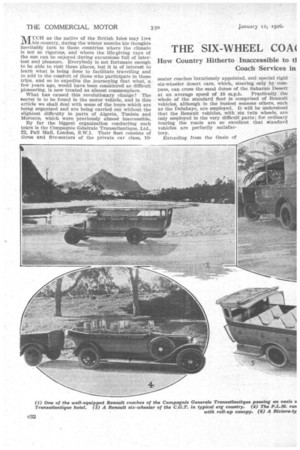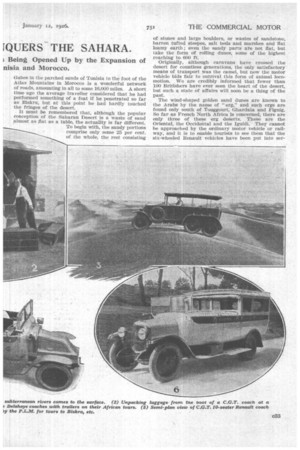THE SIX-WHEEL COA( [QUERS THE SAHARA.
Page 16

Page 17

Page 18

Page 19

If you've noticed an error in this article please click here to report it so we can fix it.
How Country Hitherto Inaccessible to ti Coach Services in ; Being Opened Up by the Expansion of nisia and Morocco.
MUCH as the native of the British Isles may hve his country, during the winter months his thoughts inevitably turn to those countries where the climate is not so rigorous, and where the life-giving rays of the sun can be enjoyed during excursions full of intertest and pleasure. Everybody is not fortunate enough to be able to visit these places, but it is of interest to learn what is being done to facilitate travelling and to add to the comfort of those who participate in these trips, and so to expedite the journeying that what; a few years ago, would have been considered as difficult pioneering, is now treated as almost commonplace.
What has caused this revolutionary change? The r,ecret is to be found in the motor vehicle, and in this article we shall deal with some of the tours which are being organized and are being carried out without the slightest difficulty in parts of Algeria, Tunisia and Morocco, which were previously almost inaccessible.
By far the biggest organization conducting such tours is the Compagnie Generale Transatlantique, Ltd., 22, Pall Mall, London, S.W1. Their feet consists of three and five-seaters of the private car class, 10 seater coaches luxuriously appointed, and special rigid six-wheeler desert cars, which, steering only by compass, can cross the sand dunes of the Saharan Desert
at an average speed of 18 m.p.h. Practically the whole of the standard fleet is comprised of Renault vehicles, although in the busiest seasons others, such as the Delahaye, are employed. It will be understood that the Renault vehicles, with six twin wheels, are only employed in the very difficult parts; for ordinary touring the roads are so excellent that standard vehicles are perfectly satisfactory.
Extending from the Oasis of
Gabes in the parched sands of Tunisia to the foot of the Atlas Mountains in Morocco is a wonderful network of roads, amounting in all to some 16,000 miles. A short time ago the average traveller considered that he had performed something of a feat if he penetrated so far as Biskra, but at this point he had hardly touched the fringes of the desert.
It must be remembered that, although the popular conception of the Saharan Desert is a waste of sand
almost as Bat as a table, the actuality is far different. To begin with, the sandy portions comprise only, some 25 per cent. of the whole, the rest consisting
of stones and large boulders, or wastes of sandstone, barren tufted steepes, salt beds and marshes and flat loamy earth ; even the sandy parts are not flat, but take the form of rolling dunes, some of the highest reaching to 600 ft.
Originally, although caravans have crossed the desert for countless generations, the only satisfactory" means of transport was the camel, but now the motor vehicle bids fair to outrival this form of animal locomotion. We are credibly informed that fewer than 100 Britishers have ever seen the heart of the desert, but such a state of affairs will soon be a thing of the past.
The wind-shaped golden sand dunes are known to the Arabs by the name of "erg," and such ergs are found only south of Touggourt, Ghardaia and Figuig. So far as French North Africa is concerned, there are only three of these erg deserts. These are the Oriental, the Occidental and the Iguidi. They cannot be approached by the ordinary motor vehicle or railway, and it is to enable tourists to see them that the six-wheeled Renault vehicles have been put into ser v. ee. They have enabled hitherto inaccessible oases and raraparted mud cities to be visited in the ordinary course, The new route of the Compagnie Generale Transatlantique is known as the Grand Tour, and the itinerary is Algiers, Boghar, Laghouat, Ghardaia, El Golea, Fort Mae.Mahon, Timimoun, Foum el Khreneg, ligli, Beni Abbes, Figuig, and Oran, which can also be traversed in the reverse direction.
The method of travelling is by ordinary vehicles between Algiers and Ghardaia, where the road 'ends, and thence by the Renault six-wheelers to the Oasis of Fignig, from which point a light railway, with sleeping and dining ears, conveys the tourists to Oran.
The time occupied between Algiers and Oran, or vice versa, is 22 days. It is a unique tour through fantastic scenery. At the chief stopping points the company have erected special Transatlantique hotels: as, of course, the provision of suitable hotel accommodation is the crux of successful touring organization, for, without them, no coach fleet, however good, could give satisfaction, and, although all are equipped in the most modern manner, some are actually Moorish palaces 500 years or more old. Those actually in the desert are equipped with wireless transmitting and receiving apparatus, so that, in the event of any vehicles not arriving, information can be immediately sent and relief vehicles despatched; also, normally, as an extra safeguard, the six-wheelers travel in pairs.
At this point it may he wise to clear up a misunderstanding which is somewhat prevalent. This is that it is unsafe to travel in French Morocco and along the seaboard because of the military operations now taking place in the Riff. These hostilities are actually entirely confined to the/mountains of the north and in territory which has never in the past been open to visitors. It is impossible for the Riffs to descend to tile plains. The hotels have been open all the summer, and the Compagnie Generale Transatlantique services are running quite normally. Advance bookings for the tours are very heavy, and the French zone is already thronged with visitors.
At some of the most enchanting spots in the Grand Tour, permanents camps, embodying every home comfort, have been installed, and ladies and even children can travel without the least discomfort or fatigue, although the terrain has never before been open to tourists.
A short résumé of the Grand Tour may be of interest. Leaving Algiers, the vehicles pass the peaks of the Saharan Atlas, through the palm and orange groves of Laghouat to Ghardaia, this occupying some three days. Then follow 12 days on the desert cars, the tourists having their luggage, and being accompanied by European and native guides, cooks and attendants. The course followed is due south, and the way lies through absolutely arid, stony desert, across sunken walys and through narrow defiles with ovelc hanging red sandstone cliffs to the City, of El Golea; which is as beautiful as 'its name, "The Pearl of the Desert," implies.
Still southbound, the vehlcles cross a ,rocky desert to Fort MacMahon and Timimoint, which is a city with towering embattlement, mud-brick houses, mosques and minarets. Beyond the city the verdure extends to the Sebkra, a salt bed some 50 miles long. More than 10,000 camels pass through Timimoun annually. One wonders if these will ever be entirely replaced by motor vehicles.
From here to the next town the course follows the edge of the great Erg Occidental, which extends for some 300 miles and is seen for many days.
Thence the route follows the famous Valley of the Saoura by "The Way of the Palms." _All caravans travelling north and south pass by here, as they have done for 1,000 years or more. The mirage Is a daily phenomenon in these districts. Finally, the greatest of oases in Africa, that of Figuig, is reached, from which the return is made via the light railway already mentioned.
As an example of the length of the tours, that from Marseilles via Algiers, Fez, Casablanca and Bordeaux occupies 28 days, and includes 1,428 miles of travel by motor vehicle. The inclusive price after Sanuary 1st is 7,600 francs, or approximately £60.
The Grand Tour, which we have described in detail, and which includes 22 days in North rfrica and a road and desert mileage of nearly 1,200, costs 12,000 francs, or approximately £95 return from Marseilles.
Those travellers who desire shorter excursions are also catered for by the Paris, Lyons and Mediterranean Railway, 179, Piccadilly, London, W.I, through their contractors, of whom the most important in Algeria is H. Catelan.
One of the longest tours is known as the Circuit du M'Zab. It includes Bon Saada, Laghouat and Ghardaia, and occupies nine days. It is performed partly by coach and partly by ,rallway and costs 650 francs (approximately £5). A trip from Algiers to the wonderful Oasis of Bou Saada occupies three days, and the cost, including return journey, is only 220 francs, or about 15s. Quite apart from the other aspects of the tour, there are marvellous ruins of the Roman occupation.
One of the most striking features of transport in Northern Africa is the extensive use which is made of trailers by the native population, European residents and those conducting tours. In Britain and the chief Continental countries it is the practice, when carrying out extensive tours, to send passengers' baggage in advance except in those few instances where ample space for the purpose is provided in the vehicle itself. When touring Northern Africa, however, the procedure of forwarding by rail cannot be adopted, because the railways do not penetrate into the interior, except at a few points. Consequently, any passengers' impedimenta has to be carried either on the vehicle or on a trailer.
As will be noticed from our illustrations, some of the vehicles have luggage boots, but most of the lighter types draw useful pneumatic-tyred trailers.
Before we conclude, we must certainly make reference to the very interesting tours carried out by Continental Motorways, 98, Wigmore Street, London, W.1.
For the purpose of these tours, a luxurious 14-seater coach with armchair seats and mounted on a Dennis chassis is employed. This Pullman vehicle has glasstopped tables for each seat, under which is placed a map showing every detail of the route taken. The luggage is carried beneath the car in specially built receptacles.
The longest tour is of 39 days' duration, being a combined motor and rail tour through Algeria, Tunisia, Sicily, Naples, Rome, Florence and Paris. The price for this tour is 125 guineas.
































